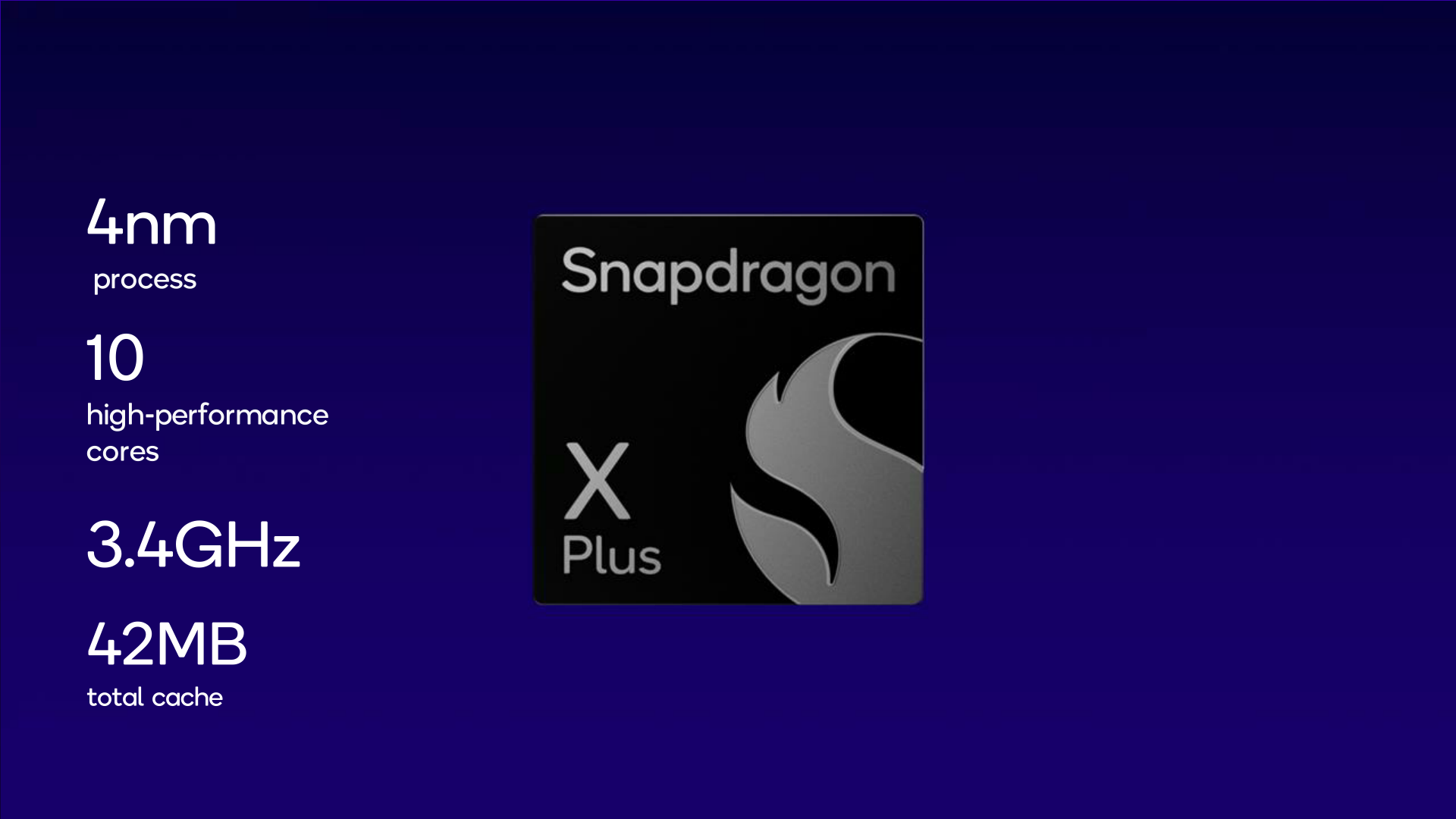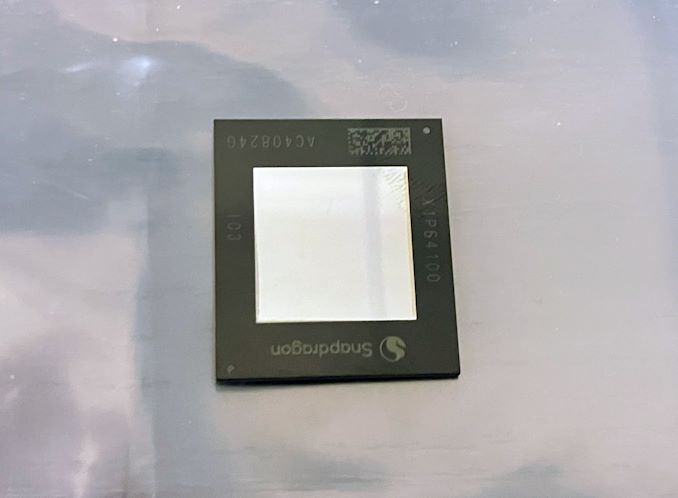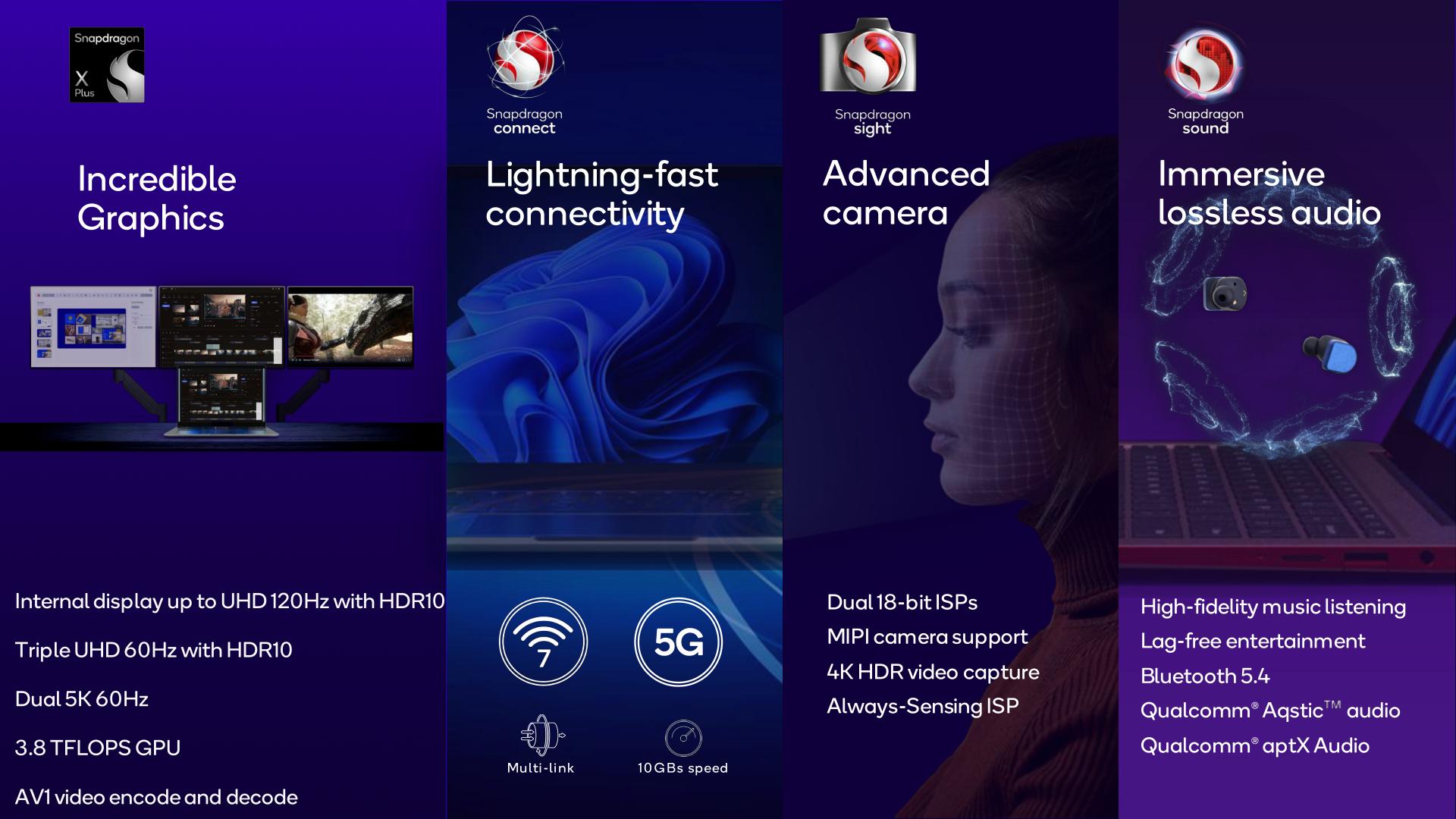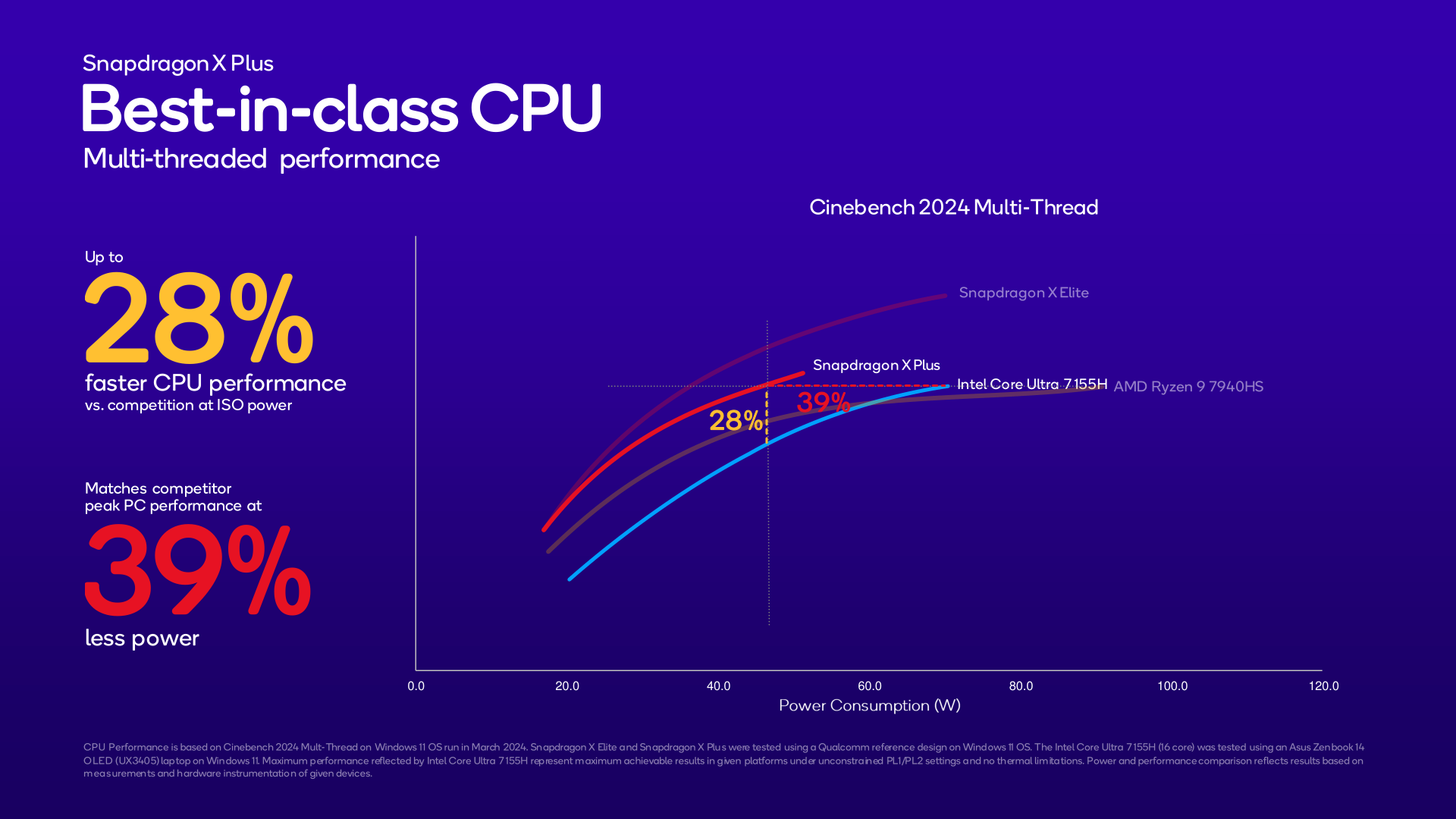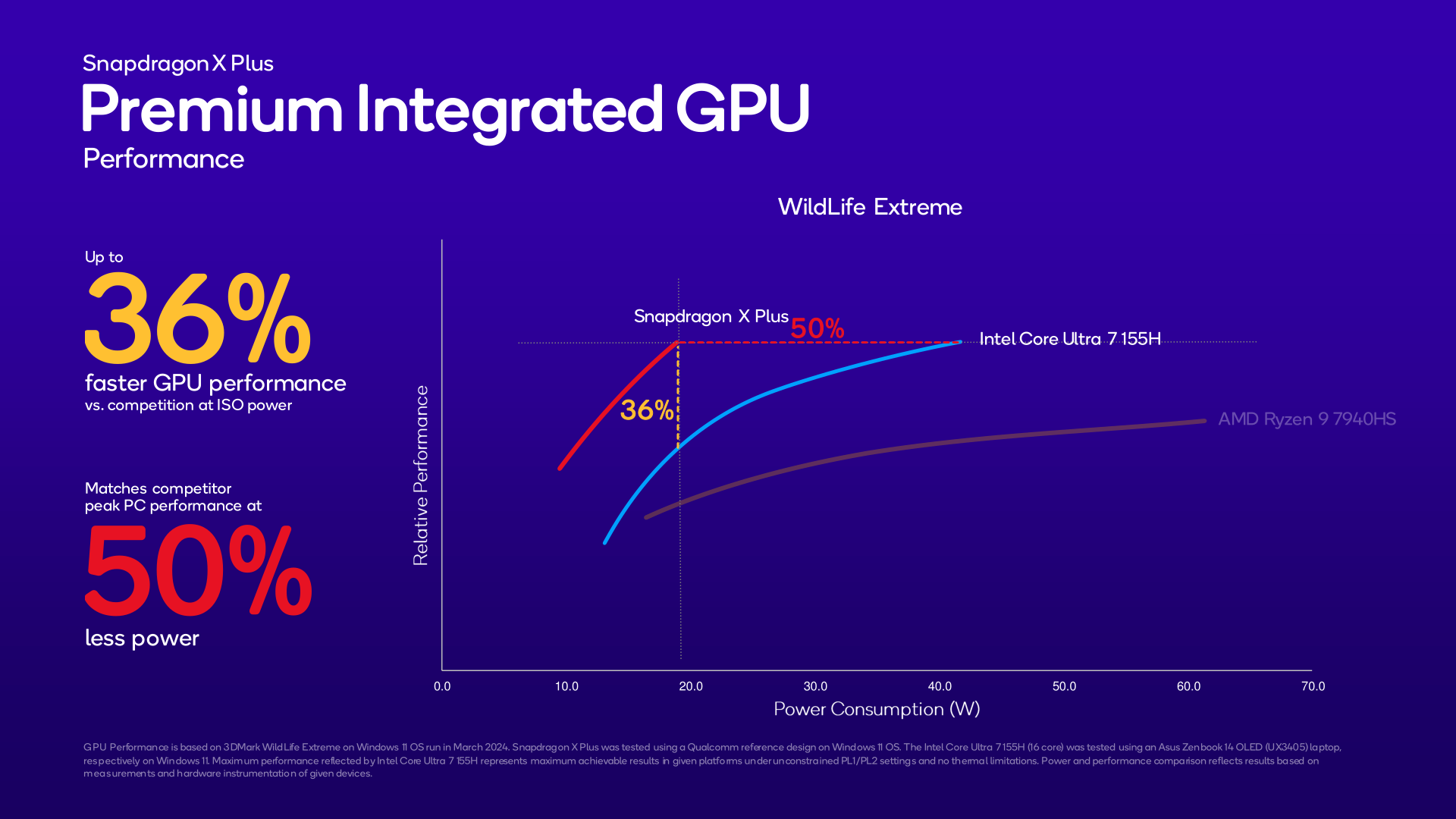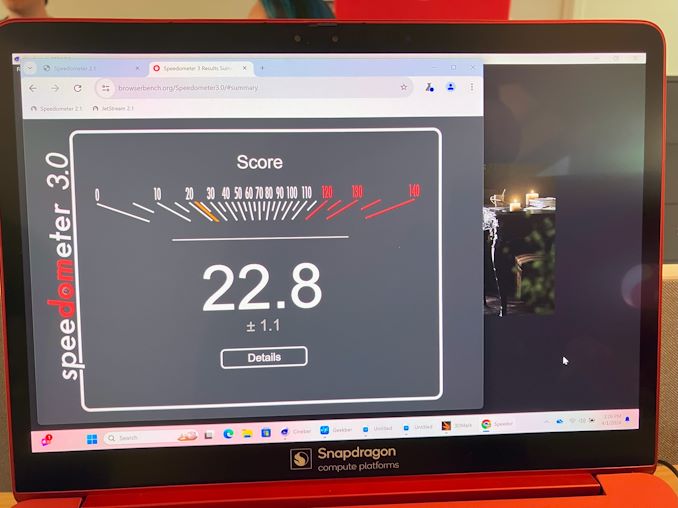
Qualcomm Intros Snapdragon X Plus, Details Complete Snapdragon X Launch Day Chip Stack
2024-04-24As Qualcomm prepares for the mid-year launch of their forthcoming Snapdragon X SoCs for PCs, and the eagerly anticipated Oryon CPU cores within, the company is finally shoring up their official product plans, and releasing some additional technical details in the process. Thus far the company has been demonstrating their Snapdragon X Elite SoC in its highest-performing, fully-enabled configuration. But the retail Snapdragon X Elite will not be a single part; instead, Qualcomm is preparing a whole range of chip configurations for various price/performance tiers in the market. Altogether, there will be 3 Snapdragon X Elite SKUs that differ in CPU and GPU performance.
As well, the company is introducing a second Snapdragon X tier, Snapdragon X Plus, for those SKUs positioned below the Elite performance tier. As of today, this will be a single configuration. But if the Snapdragon X lineup is successful and demand warrants it, I would not be surprised to see Qualcomm expand it further – as they have certainly left themselves the room for it in their product stack. In the meantime, with Qualcomm’s expected launch competition now shipping (Intel Core Ultra Meteor Lake and AMD Ryzen Mobile 8040 Hawk Point), the company is also very confident that even these reduced performance Snapdragon X Plus chips will be able to beat Intel and AMD in multithreaded performance – never mind the top-tier Snapdragon X Elite chips.
Qualcomm will be launching this expanded four chip stack at once; so both Snapdragon X Elite and Snapdragon X Plus tier devices should be available at the same time. The company’s goal is still to have devices on the shelf “mid-year”, although the company isn’t providing any more precise guidance than that. With Qualcomm’s CEO, Cristiano Amon, set to deliver a Computex keynote in June, I expect we’ll get more specific details on timings then, along with the company and its partners using the event to announce and showcase some retail laptop designs. So this is very much looking like a summer launch at the moment.
In the meantime, Qualcomm is already showing off what their Snapdragon X Plus chips can do with a fresh set of live benchmarks, akin to their Snapdragon X Elite performance previews from October 2023. We’ll dive into those in a bit, but suffice it to say, Qualcomm knows the score, and they want to make sure the entire world knows when they’re winning.
Snapdragon X Chip Stack, X Elite Gets A Nerf, and the X Product Number Decoder
With the Snapdragon X family now comprised of four SKUs, the Snapdragon X Elite name on its own won’t do. So Qualcomm is giving all of the chips official product numbers. And as this is the first time Qualcomm has done this for PC SoCs, so comes with it the need to explain their product numbering scheme, and how to decode it.
Using Qualcomm’s flagship chip as an example, we have the X1E-84-100. With the first letter referring to the product family (Snapdragon X), the second letter/digit is the generation of the product – in this case, the first generation of Snapdragon X. So this is where we’ll see Qualcomm primarily incrementing their product numbering in future generations, how ever the company decides to define them.
Following that is the tier. Which at this time is Elite (E) or Plus (P).
Finally, we have the two sets of digits. The first set is the SKU digits, basically ordering chips by performance. And the second set of digits is being reserved by the company for now for future use. For all of the chip SKUs being introduced today, everything will have the same -100 suffix, regardless of tier or performance.
It’s at first blush a very sterile naming system, but logical. The reserved portion of the SKU names makes for relatively longwinded names overall – especially as it’s not contributing anything important right now – but I don’t expect Qualcomm put it there without some plans already on paper to put it to good use. In practice, then, it’s going to be the first two segments that are the informative segments for the time being.
With that in mind, let’s take a look at Qualcomm’s Snapdragon X launch stack.
| Qualcomm Snapdragon X (Gen 1) Processors | |||||||
| AnandTech | CPU Cores | All Core Max Turbo | Two Core Max Turbo | GPU TFLOPS | NPU TOPS | Total Cache (MB) |
Memory |
| Snapdragon X Elite | |||||||
| X1E-84-100 | 12 | 3.8 GHz | 4.2 GHz | 4.6 | 45 | 42 | LPDDR5X-8448 |
| X1E-80-100 | 12 | 3.4 GHz | 4.0 GHz | 3.8 | 45 | 42 | LPDDR5X-8448 |
| X1E-78-100 | 12 | 3.4 GHz | 3.4 GHz | 3.8 | 45 | 42 | LPDDR5X-8448 |
| Snapdragon X Plus | |||||||
| X1P-64-100 | 10 | 3.4 GHz | 3.4 GHz | 3.8 | 45 | 42 | LPDDR5X-8448 |
The Snapdragon X chip family tier are being split up on the basis of the number of CPU cores. All of the Elite chips are fully-enabled parts (on the CPU side) with all 12 Oryon CPU cores enabled. Meanwhile the sole Plus chip (thus far) drops two of those CPU cores, leaving it with 10.
Heading up the chip stack is the fastest, fully-enabled Snapdragon X Elite chip, the X1E-84-100. This features all of the Snapdragon X Elite’s performance and functionality, akin to what Qualcomm has been demonstrating thus far, including the 45 TOPS NPU and the 42MB of total system cache.
Compared to their October demos, however, there are a couple of important points to point out – areas where the chip specs have been downgraded. First and foremost, the peak dual core clockspeed on the chip (what Qualcomm calls Dual Core Boost) will only be 4.2GHz, instead of the 4.3GHz clockspeeds we saw in Qualcomm’s early demos. The LPDDR5X memory frequency has also taken an odd hit, with this chip topping out at LPDDR5X-8448, rather than the LPDDR5X-8533 data rate we saw last year. This is all of 85MHz or 1GB/second of memory bandwidth, but it’s an unexpected shift since 8448 isn’t a normal LPDDR5X speed grade.
Qualcomm has not offered any explanation for the lowered specifications. I can only presume that they’ve had a harder time yielding chips with CPU cores that can hit 4.3GHz than the company was initially expecting, especially looking at the rest of the chip stack. High IPC CPU designs are inherently at odds with high clockspeeds, so with Qualcomm’s Nuvia design team targeting some very high IPCs with Oryon, it seems they’re going straight for their practical clockspeed limit with their top chip.
Following the flagship SKU is the X1E-80-100. This part is still fully-enabled from a hardware standpoint, but it drops down in both CPU and GPU clockspeeds. On the CPU front, the dual-core turbo boost is now 4.0GHz, a 200MHz (5%) decrease; meanwhile the all-core turbo limit is 3.4GHz, a more sizeable 400MHz (11%) drop from the flagship Elite chip.
As for the GPU, the rated throughput in this SKU is 3.8 TFLOPS, some 0.8 TFLOPS (17%) below the flagship chip. At present, Qualcomm has not disclosed the number of GPU blocks/cores in their Snapdragon X die, so it’s unclear whether this is just a reduction in GPU clockspeeds, or if they’re disabling GPU cores in the process. Though by PC standards, it would be unusual not to have at least one chip SKU that can be used for salvaged dies with a failed GPU core.
Rounding out the Elite SKUs is the X1E-78-100. This chip takes a further hit to CPU performance in lightly-threaded workloads. Specifically, this SKU does away with Dual Core Boost entirely, meaning none of the 12 Oryon CPU cores on the chip clocks higher than the all-core turbo limit of 3.4GHz. Compared to the X1E-80-100, this is a 600MHz (15%) clockspeed drop in lightly threaded workloads – or 800MHz (19%) drop overall compared to the flagship Elite chip.
Finally, we have the sole Snapdragon X Plus chip SKU, the X1P-64-100, this chip is identical to the bottom-tier Elite chip in everything but the CPU core count; rather than all 12 Oryon CPU cores, only 10 are enabled here. Otherwise it’s feature-identical to the Elite chips, and none of the memory bandwidth, cache, or even the NPU has been touched. Even the GPU performance/configuration is identical to the mid and low Elite chips. So the only thing this chip loses out on, on paper, is multithreaded performance.
Overall, Qualcomm’s decision to stratify their Snapdragon X chip stack in this manner is certainly an interesting one. When it comes to configuring their down-level SKUs, AMD and Intel have traditionally cut their CPU clockspeeds by smaller increments, pairing that with a broader CPU core count increase. Core Ultra-H’s peak clockspeed drops by 12%, for example, while Ryzen 8040HS is just 6%.
The net impact of this is that each step down the Elite SKU stack is going to come with a significant drop in either lightly-threaded or heavily-theaded performance (depending on the SKU), with bigger drops than what we normally see. The drop in Dual Core Turbo clockspeeds is especially surprising, since system responsiveness is typically closely tied to lightly-threaded CPU performance. So we’ll see how this all bears out in performance benchmarks once the Snapdragon X family launches.
Otherwise, most other aspects of the entire stack are constant throughout. Qualcomm never touches their NPU configuration, the cache configuration, or the memory speeds. On which note, the fact that the 10 core Plus still has 42MB of total cache all but confirms that Qualcomm is using some kind of shared L2 for their CPU core clusters, which is why losing two CPU cores doesn’t impact the L2 cache. I suspect we’re looking at 12MB of L2 per cluster, with a 6MB LLC above that, but there are several permutations that could work here – and which Qualcomm hasn’t further specified at this time.
Qualcomm also isn’t officially confirming whether the Snapdragon X Plus uses the same die as the Snapdragon X Elite. But given the incredibly similar specifications and that all four SKUs are launching at the same time, it’s a foregone conclusion that this is all using Qualcomm’s initial Snapdragon X die. Overall this is par for the course for the company, as they have historically declined to disclose when their mobile SKUs have shared a die. The company is still focused on features and SKUs first and foremost, with a tendency to downplay the underlying hardware.
With that said, these SKU announcements do provide us with a bit more detail on some of the other minor hardware features of the SoC. Qualcomm’s display controller – part of their Adreno DPU block – supports 4 display outputs. This allows for a single internal display at up to 4K@120Hz, along with 3 external displays at up to 4K@60Hz. Alternatively, 5K@60Hz is supported when using just 2 external displays. Given that Qualcomm is intending for Snapdragon X to compete with Apple’s M3 SoC, a chip somewhat infamous for only supporting two displays in total, Qualcomm is eager to point out their display controller advantage.
Conversely, driving the image acquisition side of the SoC will be a pair of Qualcomm’s 18-bit Spectra ISPs. As this isn’t a smartphone SoC and won’t be attached to anything quite like a flagship smartphone camera, the capabilities aren’t quite as hefty as what we see with the likes of the Snapdragon 8 family. But the Snapdragon X chips will still support either a single camera sensor at up to 64MP, or dual sensors at up to 36MP each. And while primary storage for these devices will be NVMe SSDs going over the previously disclosed PCIe 4 bus, Qualcomm is also confirming that the SoC offers UFS 4.0 and SD 3.0 memory interfaces, which in this case would be used for removable storage.
Finally, it should be noted that Qualcomm isn’t assigning any TDPs to these SKUs. Officially, the entire Snapdragon X range is suitable for everything from thin-and-light ultrabooks to high-TDP productivity laptops, all depending on how an OEM decides to configure and cool the system. So there is no U/H/HS distinction here, as we see with AMD and Intel. That said, given that power consumption broadly scales with performance, the Plus is going to be the lowest-power chip, if only by virtue of having the lowest performance and clockspeeds.
Alongside today’s announcement of the Snapdragon X chip SKUs and the Snapdragon X Plus branding, Qualcomm put together a short presentation on the Snapdragon X Plus. Given that the underlying hardware is identical to the Snapdragon X Elite, there’s not much to talk about here in terms of technology or technical specs.
But ahead of the mid-year hardware launch, Qualcomm is providing some fresh performance slides, comparing the Snapdragon X Plus to its current-generation competition from Intel and AMD, as well as Qualcomm’s own Snapdragon X Elite. As with all vendor-provided benchmarks, these should be taken with a grain of salt. But if nothing else, it’s notable here what Qualcomm is and isn’t saying.
With 10 high-IPC CPU cores, Qualcomm should fare well in multi-threaded workloads, and this is exactly what they’re opting to promote. According to the company, the Snapdragon X Plus has a significant edge in both performance and power consumption at iso-power and iso-performance respectively. In the case of Cinebench 2024MT, that’s a 28% performance advantage over the Core Ultra 7 155H, or matching that chip’s peak performance at 39% lower power consumption.
Notably, however, what you won’t find from Qualcomm is any material promoting Snapdragon X Plus’s single-threaded performance versus any competition. With those peak clockspeeds of 3.4GHz, the Plus isn’t in a very favorable position versus the 4.8GHz Core Ultra 7 155H, even with what is presumably an IPC advantage.
As far as Qualcomm’s own chips are concerned, the Elite understandably has the advantage at any point on the curve in these MT tests. For a given architecture, a larger number of CPU cores is always the more energy efficient options, never mind the Elite’s clockspeed advantage on top of that. In any case, Qualcomm’s own figures put the Plus at about 15% behind the flagship Elite in Geekbench, and around 20% behind in Cinebench.
The company is also touting an advantage in GPU performance. Though as the benchmark in question is 3DMark Wildlife Extreme, a bencehmark that Qualcomm has already optimized for forwards, backwards, and upside-down within their drivers, I’m more interested in seeing how more PC-exclusive workloads perform. Though to Qualcomm’s credit, they’re no stranger to that space either, as they’ve been shipping Windows-on-Arm Snapdragon SoCs for several years now.
Snapdragon X Plus: Live and In Person
Finally, alongside briefing the press on the Snapdragon X Plus, Qualcomm also had some devices using the new chip SKU to show off, demonstrating the performance of the chip. This setup was similar to Qualcomm’s Snapdragon Summit preview event for the Snapdragon X Elite in October, albeit a bit more free-wheeling and hands-on now that the hardware is a bit more mature and there’s less of a chance of something going awry.
As with that preview event, Qualcomm has equipped their own internal reference design laptops with the chips. With its lower performance, all of the Snapdragon X Plus systems were the “config B” system, which is Qualcomm’s thin-and-light reference design, sporting a 14.5-inch OLED screen and designed for a total system TDP of 23 Watts.
| Qualcomm Snapdragon X Reference Test Systems (Thin and Light) | ||
| AnandTech | Snapdragon X Elite (X1E-80-100) |
Snapdragon X Plus (X1P-65-100) |
| 2 Core Max Turbo | 4.0GHz | 3.4GHz |
| All Core Max Turbo | 12C @ 3.4GHz | 10C @ 3.4GHz |
| GPU | 3.8 TFLOPS | 3.8 TFLOPS |
| RAM | LPDDR5X-8448 | LPDDR5X-8448 |
| Display | 14.5-inch OLED 2880×1800 |
14.5-inch OLED 2880×1800 |
| Thickness | 15mm | 15mm |
| Device TDP | 23W | 23W |
| Cooling | Active | Active |
| Battery | 58Wh | 58Wh |
The Elite version of this laptop was running the X1E-80-100 chip (the same chip as last time) which features a reduced performance GPU, a peak dual-core CPU clockspeed of 4.0GHz, and an all-core turbo of 3.4GHz. Meanwhile the Plus system has an identical GPU and all-core turbo clockspeed, but only 10 CPU cores with a peak dual-core CPU clockspeed of 3.4GHz.
As before, these systems were pre-configured with major benchmarks selected by Qualcomm, including Geekbench 6.2, Cinebench 2024, UL Proycon, PCMark 10, 3DMark, Blender, and new-to-Windows-on-Arm, Chrome. Qualcomm did let us touch these machines this time around, but these demos are still primarily being hosted to prove that Qualcomm is achieving the performance figures they claim.
On that note, here’s a quick rundown of Qualcomm’s performance claims, and what we observed for the Plus in action.
| Qualcomm Snapdragon X Benchmark Scores (Thin and Light) | ||||
| AnandTech | Elite – QC Expected Range | Plus – Observed | Plus – QC Expected Range | Plus vs Elite Performance |
| Cinebench 2024 ST | 121-123 | 109 | 107-109 | 89% |
| Cinebench 2024 MT | 920-980 | 860 | 825-845 | 86% |
| Geekbench 6.2 ST | 2750-2800 | 2420 | 2400-2425 | 87% |
| Geekbench 6.2 MT | 14200-14400 | 13049 | 12800-13100 | 91% |
| Chrome – Speedometer 2.1 | 450-470 | 426 | 410-430 | 91% |
| Chrome – JetStream 2.1 | 310-320 | N/A | 280-290 | 91% |
| PCMark 10 Applications | 12800-13200 | N/A | 12500-12800 | 97% |
| UL Procyon – Office Productivity | 6200-6500 | N/A | 5700-5900 | 91% |
| UL Procyon – AI CV Inference | 1750-1800 | N/A | 1750-1800 | 100% |
| 3DMark Wildlife Extreme | 37.1-38.5 fps | 37.1 | 37.1-38.5 fps | 100% |
| Blender (CPU) | 380-410 | N/A | 340-360 | 88% |
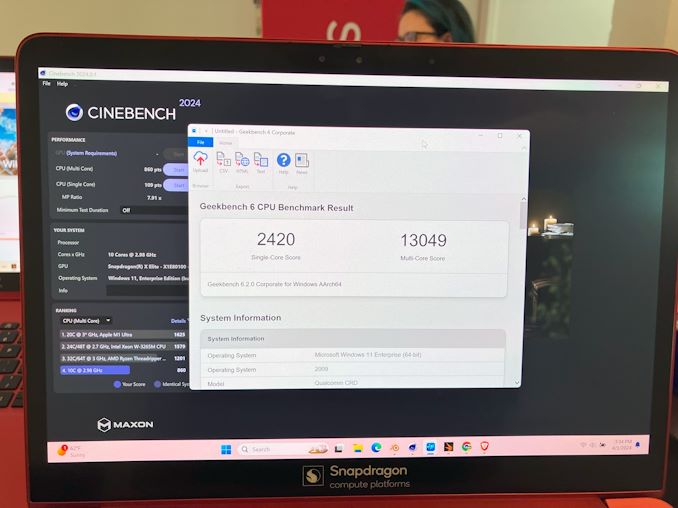
Geekbench 6.2 & Cinebench 2024
And with a little hands-on time, I even convinced Qualcomm’s representative to run the newer Speedometer 3.0 test on Chrome, which has just come out and was not yet part of their official benchmark suite. It scored 22.8.
Notably, here, the Snapdragon X Plus is closer in performance than what clockspeeds alone would predict. In Qualcomm’s supplied benchmark results, the Plus is never more than 14% behind in multithreaded workloads, and 13% behind in single-threaded workloads. And most of the time, it’s a 10% difference or less.
The 23 Watt system-wide TDP limit of the Qualcomm reference system is relatively constraining, all things considered. So I would not be the least bit surprised if the Snapdragon X Elite is being held back, in part, by not being able to run faster within Qualcomm’s systems. In other words, this is a more real-world test, as opposed to testing peak-to-peak unbounded by TDP concerns.
Overall, I don’t know if anything presented with the Snapdragon X Plus thus far would be considered all that surprising. With Qualcomm making their biggest push into the PC market yet, it makes perfect sense that they’re introducing multiple SKUs – and that they’d need some kind of branding to differentiate them. And while the Plus obviously won’t deliver the kind of chart-topping highs that the Elite will, it’s still based on all the same hardware that Qualcomm is banking on to make their reset PC ambitions a success. So like the rest of the Snapdragon X family, I’m looking forward to seeing what the hardware – Oryon CPU cores and all – can deliver when it launches in the middle of this year.

